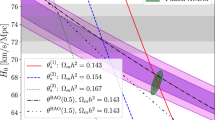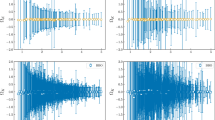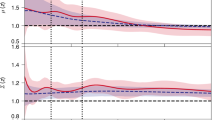Abstract
The recent Planck Legacy 2018 release has confirmed the presence of an enhanced lensing amplitude in cosmic microwave background power spectra compared with that predicted in the standard Λ cold dark matter model, where Λ is the cosmological constant. A closed Universe can provide a physical explanation for this effect, with the Planck cosmic microwave background spectra now preferring a positive curvature at more than the 99% confidence level. Here, we further investigate the evidence for a closed Universe from Planck, showing that positive curvature naturally explains the anomalous lensing amplitude, and demonstrating that it also removes a well-known tension in the Planck dataset concerning the values of cosmological parameters derived at different angular scales. We show that since the Planck power spectra prefer a closed Universe, discordances higher than generally estimated arise for most of the local cosmological observables, including baryon acoustic oscillations. The assumption of a flat Universe could therefore mask a cosmological crisis where disparate observed properties of the Universe appear to be mutually inconsistent. Future measurements are needed to clarify whether the observed discordances are due to undetected systematics, or to new physics or simply are a statistical fluctuation.
This is a preview of subscription content, access via your institution
Access options
Access Nature and 54 other Nature Portfolio journals
Get Nature+, our best-value online-access subscription
$29.99 / 30 days
cancel any time
Subscribe to this journal
Receive 12 digital issues and online access to articles
$119.00 per year
only $9.92 per issue
Buy this article
- Purchase on Springer Link
- Instant access to full article PDF
Prices may be subject to local taxes which are calculated during checkout








Similar content being viewed by others
Data availability
The data that support the plots within this paper and other findings of this study are available at http://pla.esac.esa.int/pla/#cosmology or from the corresponding author upon reasonable request.
Code availability
All of the codes used to produce the presented results are publicly available. See Methods for more details.
References
Aghanim, N. et al. (Planck Collaboration) Planck 2018 results. VI. Cosmological parameters. Preprint at https://arxiv.org/abs/1807.06209 (2018).
Aghanim, N. et al. (Planck Collaboration) Planck 2018 results. V. CMB power spectra and likelihoods. Preprint at https://arxiv.org/abs/1907.12875 (2019).
2018 Cosmological Parameters and MC Chains (Planck Legacy Archive Wiki); https://go.nature.com/2OHvQme
Linde, A. D. A new inflationary Universe scenario: a possible solution of the horizon, flatness, homogeneity, isotropy and primordial monopole problems. Phys. Lett. B 108, 389–393 (1982).
Albrecht, A. & Steinhardt, P. J. Cosmology for grand unified theories with radiatively induced symmetry breaking. Phys. Rev. Lett. 48, 1220–1223 (1982).
Linde, A. D. Inflation with variable Ω. Phys. Lett. B 351, 99–104 (1995).
Linde, A. D. Can we have inflation with Ω > 1? J. Cosmol. Astropart. Phys. 0305, 002 (2003).
Uzan, J. P., Kirchner, U. & Ellis, G. F. R. Wilkinson Microwave Anisotropy Probe data and the curvature of space. Mon. Not. Roy. Astron. Soc. 344, L65–L68 (2003).
Efstathiou, G. Is the low cosmic microwave background quadrupole a signature of spatial curvature? Mon. Not. Roy. Astron. Soc. 343, L95–L98 (2003).
Freivogel, B., Kleban, M., Rodríguez Martínez, M. & Susskind, L. Observational consequences of a landscape. J. High Energy Phys. 3, 039 (2006).
Guth, A. H. & Nomura, Y. What can the observation of nonzero curvature tell us? Phys. Rev. D 86, 023534 (2012).
Riess, A. G. et al. New parallaxes of galactic cepheids from spatially scanning the Hubble Space Telescope: implications for the Hubble constant. Astrophys. J. 855, 136 (2018).
Riess, A. G., Casertano, S., Yuan, W., Macri, L. M. & Scolnic, D. Large Magellanic Cloud cepheid standards provide a 1% foundation for the determination of the Hubble constant and stronger evidence for physics beyond ΛCDM. Astrophys. J. 876, 85 (2019).
Hildebrandt, H. et al. KiDS-450: cosmological parameter constraints from tomographic weak gravitational lensing. Mon. Not. Roy. Astron. Soc. 465, 1454–1498 (2017).
Joudaki, S. et al. KiDS-450: testing extensions to the standard cosmological model. Mon. Not. Roy. Astron. Soc. 471, 1259–1279 (2017).
Motloch, P. & Hu, W. Tensions between direct measurements of the lens power spectrum from Planck data. Phys. Rev. D 97, 103536 (2018).
Charnock, T., Battye, R. A. & Moss, A. Planck data versus large scale structure: methods to quantify discordance. Phys. Rev. D 95, 123535 (2017).
Raveri, M. & Hu, W. Concordance and discordance in cosmology. Phys. Rev. D 99, 043506 (2019).
Adhikari, S. & Huterer, D. A new measure of tension between experiments. J. Cosmol. Astropart. Phys. 1901, 036 (2019).
Bernal, J. L., Verde, L. & Riess, A. G. The trouble with H 0. J. Cosmol. Astropart. Phys. 1610, 019 (2016).
Zhao, G. B. et al. Dynamical dark energy in light of the latest observations. Nat. Astron. 1, 627–632 (2017).
Di Valentino, E., Melchiorri, A., Linder, E. V. & Silk, J. Constraining dark energy dynamics in extended parameter space. Phys. Rev. D 96, 023523 (2017).
Poulin, V., Smith, T. L., Karwal, T. & Kamionkowski, M. Early dark energy can resolve the Hubble tension. Phys. Rev. Lett. 122, 221301 (2019).
Yang, W., Pan, S., Di Valentino, E., Saridakis, E. N. & Chakraborty, S. Observational constraints on one-parameter dynamical dark-energy parametrizations and the H 0 tension. Phys. Rev. D 99, 043543 (2019).
Bond, J. R., Efstathiou, G. & Tegmark, M. Forecasting cosmic parameter errors from microwave background anisotropy experiments. Mon. Not. Roy. Astron. Soc. 291, L33–L41 (1997).
Efstathiou, G. & Bond, J. R. Cosmic confusion: degeneracies among cosmological parameters derived from measurements of microwave background anisotropies. Mon. Not. Roy. Astron. Soc. 304, 75–97 (1999).
Elgaroy, O. & Multamaki, T. On using the CMB shift parameter in tests of models of dark energy. Astron. Astrophys. 471, 65–70 (2007).
Hinshaw, G. et al. Nine-year Wilkinson Microwave Anisotropy Probe (WMAP) observations: final maps and results. Astrophys. J. Suppl. 208, 25 (2013).
Spiegelhalter, D., Best, N. G., Carlin, B. P. & van der Linde, A. Bayesian measures of model complexity and fit. J. R. Stat. Soc. B 64, 583–639 (2002).
Trotta, R. Bayes in the sky: Bayesian inference and model selection in cosmology. Contemp. Phys. 49, 71–104 (2008).
Liddle, A. R. Information criteria for astrophysical model selection. Mon. Not. Roy. Astron. Soc. 377, L74–L78 (2007).
Verdinelli, I. & Wasserman, L. Computing Bayes factors using a generalization of the Savage–Dickey density ratio. J. Am. Stat. Assoc. 90, 614–618 (1995).
Trotta, R. Applications of Bayesian model selection to cosmological parameters. Mon. Not. Roy. Astron. Soc. 378, 72–82 (2007).
Ade, P. A. R. et al. (Planck Collaboration) Planck 2015 results. XIII. Cosmological parameters. Astron. Astrophys. 594, A13 (2016).
Addison, G. E. et al. Quantifying discordance in the 2015 Planck CMB spectrum. Astrophys. J. 818, 132 (2016).
Beutler, F. et al. The 6dF Galaxy Survey: baryon acoustic oscillations and the local Hubble constant. Mon. Not. Roy. Astron. Soc. 416, 3017–3032 (2011).
Ross, A. J. et al. The clustering of the SDSS DR7 main galaxy sample—I. A 4 per cent distance measure at z = 0.15. Mon. Not. Roy. Astron. Soc. 449, 835–847 (2015).
Alam, S. et al. The clustering of galaxies in the completed SDSS-III Baryon Oscillation Spectroscopic Survey: cosmological analysis of the DR12 galaxy sample. Mon. Not. Roy. Astron. Soc. 470, 2617–2652 (2017).
Aghanim, N. et al. (Planck Collaboration) Planck 2018 results. VIII. Gravitational lensing. Preprint at https://arxiv.org/abs/1807.06210 (2019).
Abbott, T. M. C. et al. (Dark Energy Survey and South Pole Telescope Collaborations) Dark Energy Survey Year 1 results: a precise H 0 measurement from DES Y1, BAO, and D/H data. Mon. Not. Roy. Astron. Soc. 480, 3879–3888 (2018).
Hikage, C. et al. Cosmology from cosmic shear power spectra with Subaru Hyper Suprime-Cam first-year data. Publ. Astron. Soc. Jpn 71, 43 (2019).
Schlaufman, K. C., Thompson, I. B. & Casey, A. R. An ultra metal-poor star near the hydrogen-burning limit. Astrophys. J. 867, 98 (2018).
Bond, H. E., Nelan, E. P., VandenBerg, D. A., Schaefer, G. H. & Harmer, D. HD 140283: a star in the solar neighborhood that formed shortly after the big bang. Astrophys. J. 765, L12 (2013).
Jimenez, R., Cimatti, A., Verde, L., Moresco, M. & Wandelt, B. The local and distant Universe: stellar ages and H0. J. Cosmol. Astropart. Phys. 3, 043 (2019).
Cyr-Racine, F. Y., de Putter, R., Raccanelli, A. & Sigurdson, K. Constraints on large-scale dark acoustic oscillations from cosmology. Phys. Rev. D 89, 063517 (2014).
Blennow, M., Fernandez-Martinez, E., Mena, O., Redondo, J. & Serra, P. Asymmetric dark matter and dark radiation. J. Cosmol. Astropart. Phys. 1207, 022 (2012).
Mangano, G., Melchiorri, A., Serra, P., Cooray, A. & Kamionkowski, M. Cosmological bounds on dark matter–neutrino interactions. Phys. Rev. D 74, 043517 (2006).
Leonard, C. D., Bull, P. & Allison, R. Spatial curvature endgame: reaching the limit of curvature determination. Phys. Rev. D 94, 023502 (2016).
Bull, P., Ferreira, P. G., Patel, P. & Santos, M. G. Late-time cosmology with 21 cm intensity mapping experiments. Astrophys. J. 803, 21 (2015).
Lewis, A. & Bridle, S. Cosmological parameters from CMB and other data: a Monte Carlo approach. Phys. Rev. D 66, 103511 (2002).
Scolnic, D. M. et al. The complete light-curve sample of spectroscopically confirmed SNe Ia from Pan-STARRS1 and cosmological constraints from the combined Pantheon sample. Astrophys. J. 859, 101 (2018).
Cooke, R. J., Pettini, M. & Steidel, C. C. One percent determination of the primordial deuterium abundance. Astrophys. J. 855, 102 (2018).
Kazin, E. A. et al. The WiggleZ Dark Energy Survey: improved distance measurements to z = 1 with reconstruction of the baryonic acoustic feature. Mon. Not. Roy. Astron. Soc. 441, 3524–3542 (2014).
Abbott, T. M. C. et al. (Dark Energy Survey Collaboration) Dark Energy Survey Year 1 results: measurement of the baryon acoustic oscillation scale in the distribution of galaxies to redshift 1. Mon. Not. Roy. Astron. Soc. 483, 4866–4883 (2019).
Bautista, J. E. et al. Measurement of baryon acoustic oscillation correlations at z = 2.3 with SDSS DR12 Lyα-Forests. Astron. Astrophys. 603, A12 (2017).
Ata, M. et al. The clustering of the SDSS-IV extended Baryon Oscillation Spectroscopic Survey DR14 quasar sample: first measurement of baryon acoustic oscillations between redshift 0.8 and 2.2. Mon. Not. Roy. Astron. Soc. 473, 4773–4794 (2018).
du Mas des Bourboux, H. et al. Baryon acoustic oscillations from the complete SDSS-III Lyα-quasar cross-correlation function at z = 2.4. Astron. Astrophys. 608, A130 (2017).
Acknowledgements
E.D.V. acknowledges support from the European Research Council in the form of a Consolidator Grant with number 681431. A.M. thanks the University of Manchester and the Jodrell Bank Centre for Astrophysics for hospitality. A.M. is supported by TAsP, iniziativa specifica INFN. We thank M. Melchiorri for discussions.
Author information
Authors and Affiliations
Contributions
E.D.V. performed all MCMC analyses, simulations and the Planck parameters analysis at different scales, produced all the figures, wrote the paper and helped with additional ideas. A.M. proposed the main idea, performed the tension analyses and wrote the paper. J.S. wrote the paper and helped with additional ideas.
Corresponding author
Ethics declarations
Competing interests
The authors declare no competing interests.
Additional information
Publisher’s note Springer Nature remains neutral with regard to jurisdictional claims in published maps and institutional affiliations.
Rights and permissions
About this article
Cite this article
Di Valentino, E., Melchiorri, A. & Silk, J. Planck evidence for a closed Universe and a possible crisis for cosmology. Nat Astron 4, 196–203 (2020). https://doi.org/10.1038/s41550-019-0906-9
Received:
Accepted:
Published:
Issue Date:
DOI: https://doi.org/10.1038/s41550-019-0906-9



